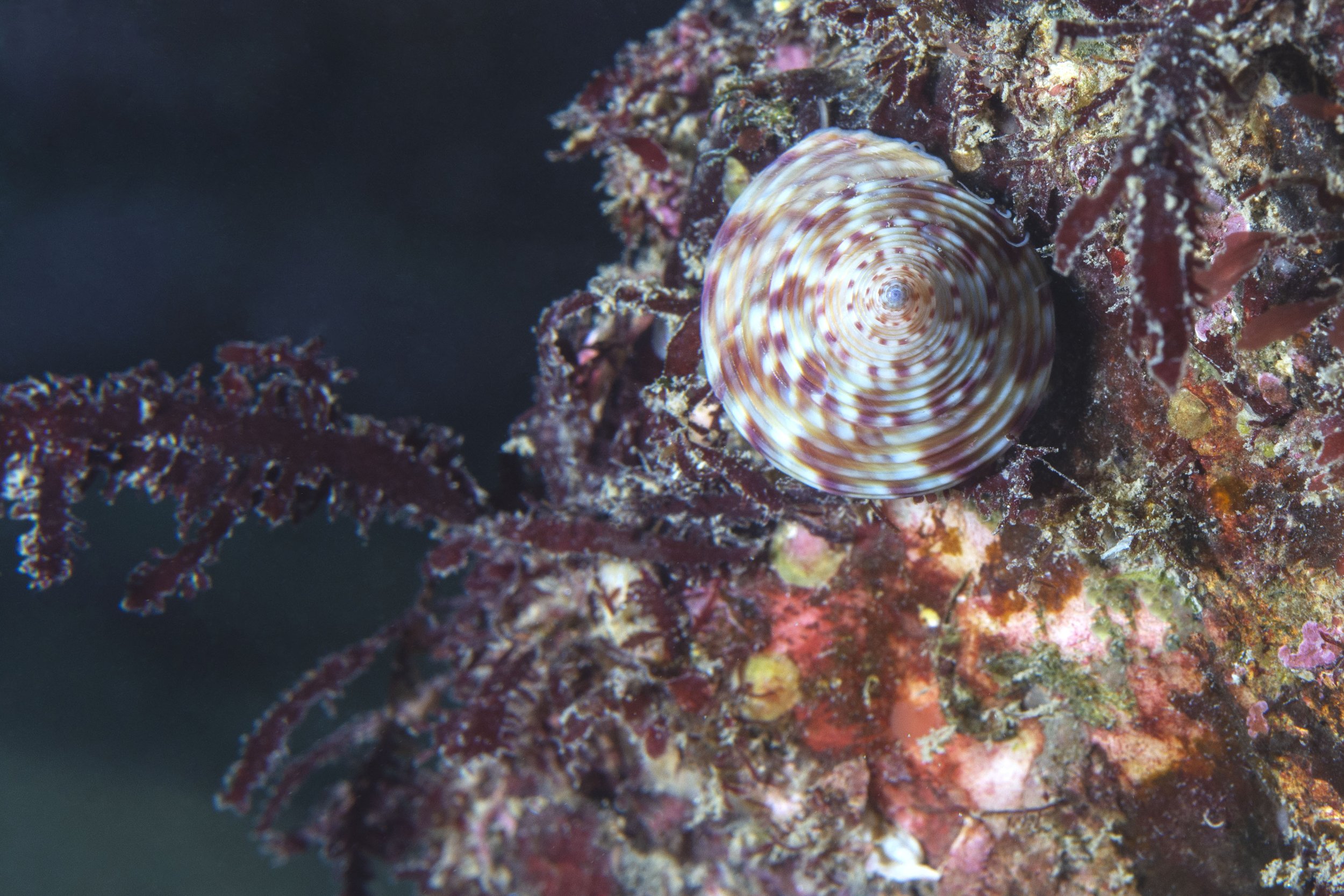Life Below the Waves
of Cornwall
by Nicole Forrester
Extra-terrestrials
A row of small, brown, oval shapes near a shell on a kelp frond attracted my attention. Upon closer inspection, I discovered that this was a colony of blue-rayed limpets (Patella pellucida) and under the light from my strobes, their shell is translucent with kingfisher blue stripes, giving the impression of alien space crafts lined up on a runway. They live on kelp and some brown seaweeds in the north-east Atlantic Ocean. The limpets attach themselves to the plant and excavate numerous pits whilst feeding.
Living Work of Art
This corkwing wrasse (Symphodus melops) darted out of the wall of kelp stalks, called stipes, and swam directly below me. It is one of the most striking reef fish found around the U.K., with a mixture of orange, pink, green and blue hues. The lateral line runs along the length of the wrasse from the area around the gills to near the tail, as shown in the image by the row of lighter scales. Each of these scales has a tiny hole which allows the water pressure to be detected by the sensory organ beneath the surface. This is the primary method for detecting changes in water pressure, activating nerve tissue in a similar way to how the human inner ear functions.
Snakelocks
Drifting close to the seabed, the bright green tentacles with purple tips flowing back and forth in the surge made the snakelocks anemone (Anemonia viridis) a fascinating subject to photograph; it is easy to see how this anemone got its name. They live attached to rocks in shallow seas within depths that the sunlight can penetrate. A symbiotic algae often resides in the tentacles, producing energy from the sunlight. Without the chlorophyll of the algae the anemone appears grey or light brown.
Feather Duster
An arrangement of four white, feathery rosettes on a rocky reef attracted by attention whilst ascending from the seabed. Three of these disappeared rapidly into tough casings, but one obligingly remained open. These are feather duster tubeworms (Sabellidae sp), aptly named for their appearance as well as their feeding technique. Living in long tubes they build around themselves out of mucous with particles of sand and shell for protection, they remain in one place attached to the rock. Feather duster tubeworms filter small fragments from the water with their plumes, called radioles. Fine hair-like cilia line the radioles and channel tiny organic particles down to the mouth, where they are ingested. Larger, inedible particles in the water are separated from the food supply and kept as building materials.
Spinning Top
Upon a shelf of the reef, a painted topshell (Calliostoma zizyphinum) grazed on an algae-covered rock. Intricate pink, tan and white whorls on the flat based conical shell give an optical illusion of it spinning like a child’s toy with an unblinking blue eye. This is the shell of a mollusc, much like a sea snail, and is found in many sheltered, rocky, coastal areas in the UK. The shell is kept clean by the mollusc using its extendable foot to remove algae.
Peeping Tom
I battled my way between kelp stipes, pushing the fronds out of my path and used the strobe lights to explore secret hiding places. This jazzy little tompot blenny (Parablennius gattorugine) perched like a bird at the entrance of its nook. With a pair of red, spiky head-tentacles, large, high-set eyes, and markings around its mouth like make-up, this fish looked dressed for the stage. With lots of attitude and showy appearance, no wonder this extravert is frequently used as an ambassador for the ocean.
Dots and Dashes
Neon dots and dashes caught my eye whilst shining a light into a crevice. A common prawn (Palaemon serratus) stood guard decorated in yellow, red-brown, and lime green with dark tiger stripes. This prawn does not look common at all, with its translucent body taking on the colour of its background and multiple glowing patterns. They are found in shallow rockpools through to waters of about 40m, forming a vital part of the marine food chain. As omnivorous scavengers, they feed on plants, algae, dead fish and remains of other sea creatures, as well as hunting small prey. In turn, prawns are food for many larger predators.
Devil Crab
The velvet swimming crab (Necora puber) gets its name from the covering of short hairs over its body. The crab photographed appeared irritated; bright red eyes glared at me and blue streaked claws looked ready for action. This species, well known for its feisty character, is often called the devil crab.
Medusa
Mid-water, detached from the rock where it began its life cycle as a polyp, an almost transparent, glowing, hydroid (Aequorea sp) drifted. In this mature form, it is called a medusa due to its trailing tentacles. This beautiful organism, with a pale-blue aura, is bioluminescent. The discovery of its protein aequorin, known as GFP (glowing green fluorescent protein) achieved the Nobel prize in 2008, for its use in molecular biology and the detection of cancer cells in humans.
Phone Number : +44 (0) 77668 70422
Cornwall, UK










